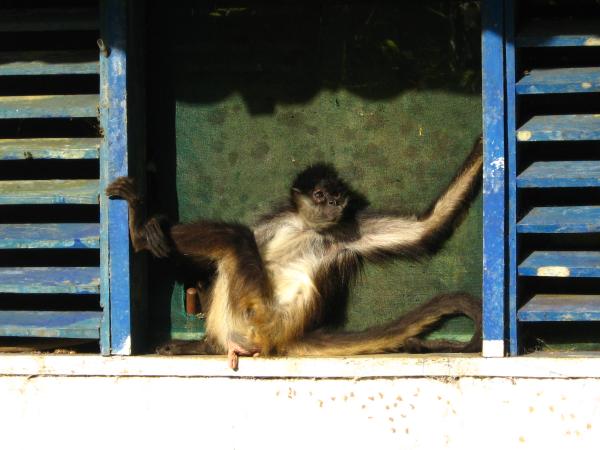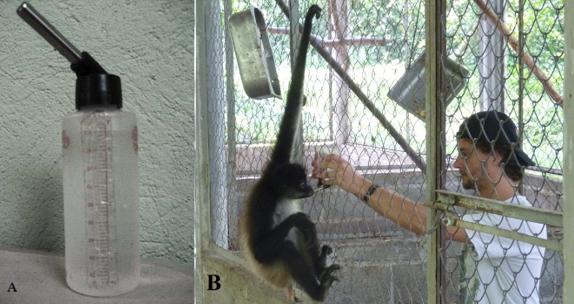Material & Methods
Animals
Testing was carried out using five male and three female adult spider monkeys (Ateles geoffroyi) aged between 4 and 25 years. The animals were kept at the field station of the Universidad Veracruzana, near Catemaco, Mexico. Not all animals participated to all three experiments, as participation was exclusively voluntary, and two of the monkeys found the first experiment not attractive enough to be worth their time.


Procedure
A two-bottle preference test of short duration was used to determine the gustatory responsiveness of the spider monkeys to ethanol diluted in different solvents. The tests were performed between three and six times per day and per individual and took place in the morning before feeding and/or in the afternoon at least one hour after feeding, with 30-minute intervals between tests. Each pair of stimuli was presented ten times. The spider monkeys were allowed to drink for 1 minute from a pair of 100mL graduated cylinders with metal drinking spouts . All the ethanol concentrations used were within a range of concentrations that can be found in naturally fermenting fruits.

Experiments
Experiment 1
Determination of absolute preference and taste preference threshold for ethanol
To assess the taste preference threshold and the absolute preference for ethanol, six spider monkeys were given the choice between purified water and different concentrations of ethanol diluted in purified water.
Experiment 2
Determination of absolute preference and taste preference threshold for sugarcane alcohol
To assess if the impurities in sugarcane alcohol affected the absolute preference and taste preference threshold, the experiment was repeated using sugarcane alcohol instead of pure ethanol.
In both the first and second experiment, testing started at a concentration of 3% ethanol and decreased as follows: 2%, 1.5%, 1%, 0.5%, 0.1%, 0.05%, etc. until an animal failed to show a significant preference or aversion. To maintain the animals’ motivation to cooperate when presented with less attractive concentrations, the testing did not follow the order of decreasing concentrations but was pseudo-randomized.
Experiment 3
Determination of relative preference for ethanol
Relative preference for ethanol was assessed by presenting eight spider monkeys with a sucrose solution in one bottle and a sucrose solution spiked with ethanol (0.1%, 0.5%, and 3%) in the other bottle. The experiment was subdivided into three test series, with the sucrose concentration of the stimuli varying between the series.
In the first test series, both the spiked and the non-spiked stimuli had a sucrose concentration of 30mM.
In the second test series, the experiment was repeated with a sucrose concentration of 60mM for both stimuli. This was done in order to assess if the degree of sweetness had an effect on the spider monkeys’ taste responsiveness to ethanol.
In the third test series, the experiment was repeated with a 60mM non-spiked sucrose solution and an ethanol-spiked (0.1%, 0.5%, and 3%) sucrose solution of 30 mM. This was done in order to assess if preference for the ethanol-spiked solution was due to it being hypercaloric compared to the non-spiked alternative in the previous test series. In this test series, the 0.1% and 0.5% ethanol-spiked sucrose solutions contained less calories than the non-spiked alternative, and the 3% ethanol-spiked sucrose solution contained more calories than the non-spiked alternative.
Experiment 4
Assessment of taste preference for alcohol in fruit matrices
To assess taste preference in conditions that aimed to mimic the overripe fruit found in the wild even better than a simple mixture of ethanol and sucrose, three different kinds of pureed fruit were presented to the spider monkeys which either were spiked with ethanol (3%) or not. Fruits used were mango (Mangifera indica), cantaloupe melon (Cucumis melo), and papaya (Carica papaya), as all three have different textures and sweetness and thus cover a certain range of the “flavour-palette” found in the spider monkeys’ diet. The fruit was pureed thoroughly enough to be presented in the same bottles as used in the previous experiments.
Data Analysis
For each test series or experiment, the volume of liquid consumed from each bottle was recorded for every trial and monkey. After ten trials, the volumes consumed from each bottle were converted into percentages relative to the total volume consumed from both bottles. The criteria for a preference at the individual level were as follows: an animal was only regarded as significantly preferring one of the two alternative stimuli if it (1) reached the criterion of 66.7% preference (relative to the total amount of liquid consumed) and (2) consumed more from the bottle containing the preferred stimulus in at least eight out of ten trials. According to the binomial test, the ratios 9/10 and 10/10 correspond to p< 0.01, and the ratio 8/10 corresponds to p<0.05.
Responsible for this page:
Director of undergraduate studies Biology
Last updated:
05/13/19
